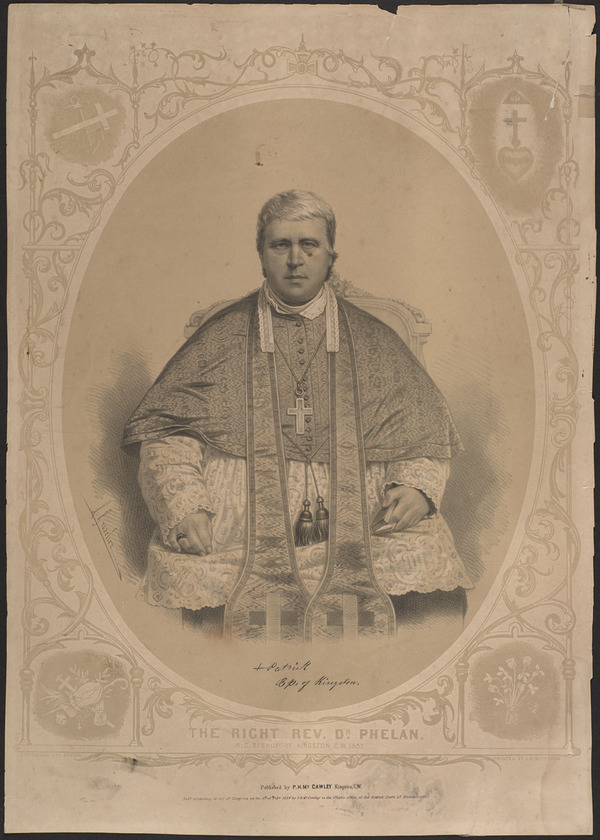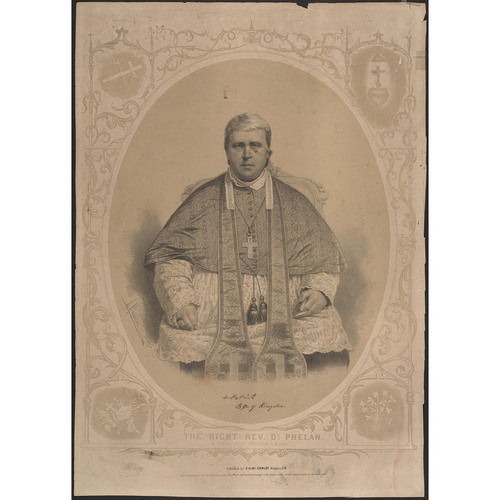PHELAN, PATRICK, Roman Catholic priest, Sulpician, and bishop; b. 1795, on or about 14 February, in Ballyragget (Republic of Ireland), son of Joseph Phelan and Catharine Brennan; d. 6 June 1857 in Kingston, Upper Canada.
After running out of funds to further his education, Patrick Phelan became a teacher in a private school but soon decided to leave for America to continue his studies there. In the words of an anonymous biographer, “The impression that God had called him to America, and that there should be the field of his real usefulness, was deeply made and it remained.” He embarked from Dublin in 1821 on the first ship sailing to America, which happened to be bound for Boston. On arrival he placed himself under the guardianship of its prelate who, three months later, sent him to Montreal to study for the priesthood. On 24 Sept. 1825, with Bishop Jean-Jacques Lartigue* presiding, Phelan became the first priest to be ordained in Montreal’s newly consecrated church of Saint-Jacques. Following “the earnest solicitation” of the Séminaire de Saint-Sulpice, Phelan was allowed to remain in Montreal to serve in its parish, Notre-Dame. After being received as a member of the seminary on 21 Nov. 1825, he spent the next 17 years ministering to the city’s Irish Catholics.
Given the nascent state of that community, his services had to embrace more than its spiritual needs. He was active in furthering the education of the young, providing medical care during the cholera epidemics of 1832 and 1834, seeing to the welfare of destitute widows and orphans, sometimes at his own expense, and, through the establishment of St Patrick’s Total Abstinence Society in 1841, trying to curb the community’s widespread abuse of alcohol. According to his biographer, Phelan’s service during the epidemics “made such a great impression on the minds of his congregation, that they ever after had unlimited confidence in him.” The timing was fortunate because Phelan soon needed to make demands on that trust. The first involved Maria Monk*, a former resident of the Montreal area who falsely claimed to have spent several years in a convent there and who, in the summer of 1835, began making slanderous allegations about members of the city’s Catholic clergy. In one of many outrageous statements, she said that Phelan was the father of her illegitimate child and that conception had taken place in the convent. Phelan had little difficulty surviving the accusations and Maria Monk was soon revealed to be a liar and a prostitute. Another incident occurred during the political disturbances of 1837 when members of Montreal’s Irish community spoke of holding an assembly under the Patriote orators Edmund Bailey O’Callaghan* and Thomas Storrow Brown*. Phelan’s superior, Joseph-Vincent Quiblier, sent him to restore calm, which he did by preaching on the need to obey the government.
Perhaps as the result of favourable impressions Phelan made on missionary visits to the Ottawa valley in 1838 and 1841 (the latter in the company of Bishop Charles-Auguste-Marie-Joseph de Forbin-Janson*), Bishop Rémi Gaulin of Kingston, Upper Canada, requested in 1842 that Phelan be appointed parish priest of Bytown (Ottawa). Acceding to the request, church authorities created him vicar general of the dioceses of Montreal and Kingston. Prior to his departure, leading members of his parish, including John Ponsonby Sexton* and John Michael Tobin, presented him with a eulogistic farewell address, and the Irish soldiers of the Montreal garrison gave him an ornamental silver snuff-box in grateful memory of his services to them. Phelan took charge of the Bytown parish on 22 Nov. 1842, and was joined about a month later by an assistant, Hippolyte Moreau*.
It was at this time that Bishop Gaulin was suffering from the physical and mental debilities that forced the Canadian episcopate to replace him with a coadjutor bishop to administer a diocese then covering the entire eastern half of Upper Canada. Rome concurred in the choice of Phelan, but Gaulin, who only a short time earlier had spoken warmly of him, bitterly denounced him when he learned of the appointment in April 1843. Then began the most difficult years of Phelan’s ministry.
On 20 Aug. 1843, in Montreal, bishops Ignace Bourget*, Pierre-Flavien Turgeon*, and Michael Power* consecrated Phelan bishop of Carrhae and coadjutor to the bishop of Kingston with right of succession. The new bishop had much to contend with. The diocese of Kingston, in common with others of the time, needed schools, hospitals, orphanages, and churches, as well as qualified clergy and religious to serve in them. Phelan had the additional problem of rarely being free of Gaulin’s interference, even while the latter resided in Lower Canada (1843–49 and 1852–57). Gaulin initially refused to give up the idea of staying in the bishop’s residence in Kingston, denied Phelan access to diocesan records, and allowed his housekeeper to maintain a spirited defence of his offices and effects. Only gradually, and then largely through the continuing encouragement and counsel of Bishop Bourget, did Phelan manage to assume the administration of the diocese.
Despite the opposition he encountered, Phelan achieved impressive results. The Oblates of Mary Immaculate established themselves in Bytown in 1844, as did the Grey Nuns a year later [see Elisabeth Bruyère*]. The Religious Hospitallers of St Joseph arrived in Kingston in 1845 to establish a hospital for the town. The diocese of Bytown was created in part from Kingston’s territory two years later and its first bishop, Joseph-Bruno Guigues*, was consecrated in 1848. In the same year the first Jesuit began teaching at Kingston’s Regiopolis College. Phelan, whose first official act in Kingston had been to lay the cornerstone of St Mary’s Cathedral, participated in consecrating the church on 4 Oct. 1848 [see Patrick Dollard*]. Phelan’s service and potential were recognized two years later when Turgeon appointed him vicar general of the archdiocese of Quebec. In 1853 the Christian Brothers established a school in Kingston, and in 1855 a separate school system was organized there. Phelan consecrated John Farrell*, the first bishop of Hamilton, in 1856, and welcomed the Loretto sisters to Belleville a year later [see Ellen Dease*]. Educational institutions also appeared in St Andrews and Alexandria during his administration. But all progress was achieved only at the cost of severe and continuing personal rancour brought about by Gaulin’s refusal to give up his power, increasingly incapable though he was of exercising it.
Most of Gaulin’s resistance to Phelan was petty, with the exception of his attempt between 1849 and 1852 to resume control of the diocese. After moving back to Kingston, Gaulin made appointments to a number of diocesan offices and undertook far-reaching projects, only to have the Canadian episcopate promptly remind him that all power resided in Phelan. The pope’s personal intervention warning Gaulin against further involvement in the government of the diocese was required to bring about his return to Lower Canada and to restore calm. Phelan managed to settle all these challenges to his authority, but never without a great deal of anguish as well as protracted negotiations and correspondence.
Gaulin’s lengthy struggle with his illness ended when he died on 8 May 1857. Phelan, after 14 years of intense labour trying to handle the myriad problems of administering a diocese while coping with a sick man’s interference at every step, at last succeeded to the bishopric free of personal encumbrances. His freedom, and the sense of relief that must have accompanied it, were to be short-lived. While attending Gaulin’s funeral in Kingston on 13 May, Phelan contracted a cold. Several days later, feeling somewhat recovered, he went to Belleville, the scene of his first pastoral visit as coadjutor, to attend the consecration of the new cemetery. An account in the Toronto Mirror, perhaps written by its publisher, Charles Donlevy, stated: “Here, from exposure to the open air a second time, he caught an inflammation of the lungs. . . . Upon his return to Kingston, the disease increased in virulence, and on the night of Saturday, the 6th of June, he breathed his last in the arms of his faithful and beloved clergy, and after the last sacraments had been administered by Bishop Bourget.” Like his predecessor, Phelan was buried in St Mary’s Cathedral. The fourth bishop of Kingston, Edward John Horan*, was consecrated the following May.
ACAM, 255.102, 842-16; 843-2, -8–9, -12–13; 844-3; 845-2, -6; 851-1; 255.104, 842-4; RC, I: ff.125–28v. AO, RG 22, ser.155, will of Patrick Phelan. Arch. of the Archdiocese of Kingston (Kingston, Ont.), BI (Remigius Gaulin, corr.), 2ED3-6–7; 2ER1-7–8; 2CL1-15; C (Patrick Phelan papers). Life of Right Reverend Patrick Phelan, third bishop of Kingston, to which is added a synopsis of the lives of the two first bishops of Kingston; by the clergyman who served Bishop Phelan’s last mass (Kingston, 1862). Maria Monk, Awful disclosures of Maria Monk . . . (New York, 1836), 16, 228–29, and Awful disclosures, by Maria Monk, of the Hotel Dieu nunnery of Montreal, revised, with an appendix . . . (New York, 1836), 240, 307–21, 330, 337, 346–47; both repr. in Awful disclosures of the Hotel Dieu nunnery, intro. R. A. Billington (Hamden, Conn., 1962). British Whig, 7 Oct. 1848. Chronicle & Gazette, 15 July, 12, 23 Aug., 9 Sept. 1843. Daily British Whig, 8, 12 June 1857. Toronto Mirror, 6, 13 Oct. 1848; 15, 22 May, 12, 19 June 1857. Caron, “Inv. de la corr. de Mgr Plessis,” ANQ Rapport, 1928–29. L.-A. Desrosiers, “Correspondance de Mgr Ignace Bourget . . . ,” ANQ Rapport, 1945–46, 1948–49; “Inv. de la corr. de Mgr Lartigue,” 1941–42, 1945–46. Léon Pouliot et François Beaudin, “Correspondance de Mgr Ignace Bourget . . . ,” ANQ Rapport, 1955–57, 1961–64, 1969. Gaston Carrière, Histoire documentaire de la Congrégation des missionnaires oblats de Marie-Immaculée dans l’Est du Canada (12v., Ottawa, 1957–75), 1: 219, 223; 4: 123. L. J. Flynn, Built on a rock; the story of the Roman Catholic Church in Kingston, 1826–1976 (Kingston, 1976) [reproduces a portrait of the subject]. Labarrère-Paulé, Les instituteurs laïques, 59–60, 75. Robert Rumilly, Histoire de Montréal (5v., Montréal, 1970–74), 2: 229, 282.
Cite This Article
J. E. Robert Choquette, “PHELAN, PATRICK,” in Dictionary of Canadian Biography, vol. 8, University of Toronto/Université Laval, 2003–, accessed December 21, 2025, https://www.biographi.ca/en/bio/phelan_patrick_8E.html.
The citation above shows the format for footnotes and endnotes according to the Chicago manual of style (16th edition). Information to be used in other citation formats:
| Permalink: | https://www.biographi.ca/en/bio/phelan_patrick_8E.html |
| Author of Article: | J. E. Robert Choquette |
| Title of Article: | PHELAN, PATRICK |
| Publication Name: | Dictionary of Canadian Biography, vol. 8 |
| Publisher: | University of Toronto/Université Laval |
| Year of publication: | 1985 |
| Year of revision: | 1985 |
| Access Date: | December 21, 2025 |




